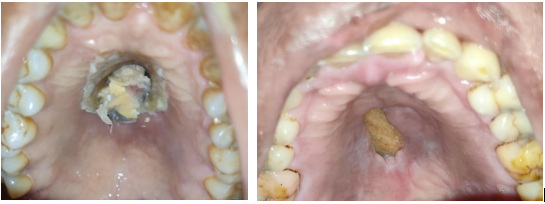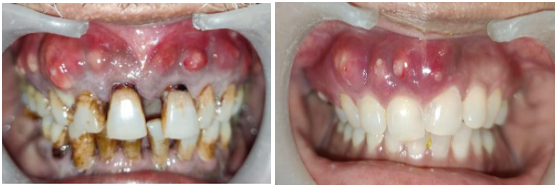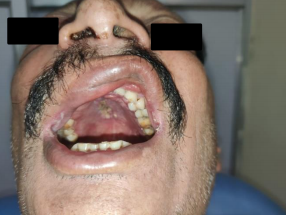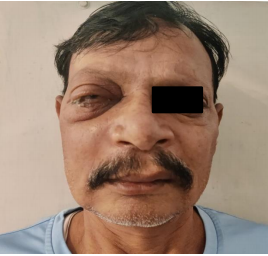Sahana Sadasivam1*, Geeta IB2
1Department of Conservative Dentistry and Endodontics, Rajarajeswari Dental College, Bangalore, India
2Head of Department and Professor, Department of Conservative Dentistry and Endodontics, Rajarajeswari Dental College, Bangalore, India
*Corresponding Author: Sahana Sadasivam, Department of Conservative Dentistry and Endodontics, Rajarajeswari Dental College, Bangalore, India; Email: [email protected]
Published Date: 01-07-2021
Copyright© 2021 by Sadasivam S, et al. All rights reserved. This is an open access article distributed under the terms of the Creative Commons Attribution License, which permits unrestricted use, distribution, and reproduction in any medium, provided the original author and source are credited.
Abstract
The World Health Organization declared the outbreak of corona virus as a public health emergency of international concern on 30th January 2020. It has been over a year and a half since this outbreak and has led to heavy casualties across the globe. New mutant strains of the virus have said to emerge over the past year leading to the demise of people from various age groups. The most common symptoms of symptomatic covid positive patients include fever, dry cough, tiredness and less common symptoms include aches and pains, sore throat, diarrhoea, headache, loss of taste and smell. Some of the serious complications include difficulty in breathing/shortness of breath, chest pain or pressure. A new recently emerged complication of COVID-19 is a rare fungal infection also called the black fungus caused by a group of fungi called mucormycetes. These group of fungi commonly appear throughout the environment, particularly in association with decaying organic matter and in the soil. Contact with these fungal spores is very common as it is spread out in the environment but usually do not pose a greater harm or risk. The frequency of the black fungus in COVID patients is increasing due to immunodeficiency states like diabetes, malignancies, hematopoietic disorders, poor oral hygiene and immunosuppressive drugs. Oral health is essential to general health and greatly influences the quality of life. Early detection and proper care can prevent this disease from becoming fatal. Maintaining oral health is of utmost importance in preventing fungal infections becoming debilitating. This article a guide to oral health with key points to prevent any opportunistic organism giving its way in compromising general health.
Keywords
Corona Virus; Global Pandemic; Fungal Infection; Oral Mucormycosis; Black Fungus; Opportunistic Infections; Oral Health
Introduction
Severe Acute Respiratory Syndrome Coronavirus 2 (SARS-CoV-2) is an, enveloped RNA beta coronavirus that emerged in Wuhan, China, in December 2019 [1]. It is the cause of a severe aggressive global pandemic called COVID-19.
The complete spectrum of COVID-19 ranges from mild, self-limiting respiratory tract disease to ruthless progressive pneumonia, multiple organ dysfunction, and death [2]. A recent post COVID-19 complication seen in patients is a rare fungal infection known as the “Black Fungus” or Mucormycosis [3].
Mucorales the cause of mucormycosis is a life threatening fungal infection mainly affecting the immunocompromised hosts [4]. The most frequent sites of infection are pulmonary, rhinocerebral, cutaneous and disseminated. It is a potentially lethal, angioinvasive fungal infection predisposed by diabetes mellitus, immunosuppressive drugs, hematological malignancies, variconozole therapy, corticosteroids, solid organ transplantation, etc [5]. Reversal of the underlying conditions is mandatory for controlling the spread of this infection which may otherwise turn fatal.
Maintaining oral health is of utmost importance to prevent the spread of such infections. Most common type of mucormycosis being rhino-maxillary disease in which patients might report primarily to a dental practitioner for oral cavity related complains [6].
Clinical Manifestations of Oral Mucormycosis
Clinical Diagnosis and Red Flags in oral Mucormycosis (Fig. 1-4) [7]
- Dental Pain
- Mobile Teeth
- Halitosis
- Nasal stuffiness
- Nasal Discharge with epistaxis, black purulent discharge
- Para-sinusal pain
- Intraoral Draining Sinuses
- Erythema of nasal mucosa
- Palatal Ulceration
- Facial Erythema
- Black Discoloration of Skin
- Periorbital erythema and edema
- Orbital Pain,Ptosis,Diplopia
- Fever

Figure 1: Palatal ulceration secondary to mucormycosis.

Figure 2: Multiple intra-oral sinus with mobile teeth.

Figure 3: Upper lip edema with black nasal discharge.

Figure 4: Orbital cellulitis.
The oral cavity houses numerous opportunistic fungi which causes an infection in immunocompromised states like malignancies, organ transplantation, diabetes mellitus etc. This article is a guide to maintain oral health post COVID-19 scenario in order to avoid such opportunistic infections leading to fatality.
Radiographic Diagnosis of Mucormycosis
Early Radiographic imaging and diagnosis is helpful in assessing the extent of involvement of this fungal disease which requires prompt and aggressive treatment [8].
Few of the radiographic techniques employed are:
- Gold Standard-Gadolinium Enhanced MRI [9]
- Adjuvant Imaging-CT PNS with contrast
Radiographic Features Include
Features on MRI [10]
- Perisinusal Spread
- Black Turbinate Sign(First Sign)
- High intensity signal in fat suppressed
- Osseous erosion
Features on Contrast Enhanced CT-PNS
- Mucosal Thickening
- Inflammation of Nasal Turbinate
- Bony Erosion
- Fluid Filled Sinus
- Sequestered Bone
Lab Investigation for Diagnosis of Mucormycosis
- Deep Nasal Swab for KOH smear and Fungal Culture [11]
- CRP level
- Negative Galatomannan and Beta-Glucan Test(to exclude aspergilosis) [12]
- Biopsy
- 50% tissue in saline for fungal culture
- 50% tissue in 10% formalin for histopathology
A Guide to Oral Health
WHO defines oral health as “a state of being free from chronic mouth and facial pain, oral and throat cancer, oral infection and sores, periodontal (gum) disease, tooth decay, tooth loss and other diseases and disorders that limit an individual’s capacity in biting, chewing, smiling, speaking and psychosocial well-being”.
Mucormycosis a rapidly progressive and often fatal opportunistic infection is a condition which was first described by Paltauf in 1885. The first manifestation of this disease was noted in the facial tissues and oral cavity.
It is very important that patients are educated to maintain an extremely high level of oral hygiene in order to avoid further opportunistic infections giving way to secondary complications in an already debilitating condition.
According to an online cross-sectional questionnaire survey conducted in Wuhan and China of the impact of COVID-19 on the oral health of adults “it concluded that the three most common oral problems amid the epidemic were gingival bleeding, bad breath and oral ulcers” [13].
Important Oral Health Guidelines Include
- Keeping these opportunistic infections in mind Covid positive patients should therefore be advised to brush their teeth at least twice a day and regular flossing [14].
- Steam inhalation to improve ciliary function and sinus health.
- Povidone-iodine with a concentration level of 1% should be recommended to be used at least 3-4 times a day which will not only decrease dental emergencies but also decrease the viral load in the oral cavity.
- Patients with a known history if Diabetes should be under Strict glycemic control.
- Patients with fixed prosthesis or dentures should carefully monitor their oral health and notice for any changes in the mucosal tissues and should report immediately if any such changes seen.
- Fungal infections usually begin with an ulcer hence careful monitoring of hospitalized as well as home-quarantined patients should be taken care of.
- For intubated patients’ high levels of oral hygiene protocol has to be followed. A single use tooth brush to be used to clean their teeth and small gauze should be used to clean the soft tissues. Followed by use of 1% Povidone-Iodine mouthwash and a gauze to slowly massage the gingiva.
- Dentures of Intubated should also be cleaned with a single use toothbrush and a small gauze piece.
- Change of toothbrush in covid recovered patients has been advised in order to prevent re-infection or cross contamination within the family.
- Use of Tablet Vitamin E 1000 IU Tablet Vitamin A 6000 IU and B complex tablets and high protein low sugar diet is advised to be followed.
- Patients should be made aware of the importance of oral health in condemning the spread of the disease and should be educated to maintain good oral hygiene which would further prevent colonization of opportunistic bacteria or fungi and hence preventing fatality.
Conclusion
The global pandemic has created a black hole in everyone’s life. Self-awareness of what is happening around is very important. Maintaining and following the set protocols will make our lives a better place to live in. We, as dentists have the opportunity to promote oral health and bring out its importance in order to prevent any fatality occurring due to negligence.
References
- Lu R, Zhao X, Li J, Niu P, Yang B, Wu H, et al. Genomic characterisation and epidemiology of 2019 novel coronavirus: implications for virus origins and receptor binding. The Lancet. 2020;395(10224):565-74.
- Izda V, Jeffries MA, Sawalha AH. COVID-19: A review of therapeutic strategies and vaccine candidates. Clin Immunol. 2020:108634.
- Ahmadikia K, Hashemi SJ, Khodavaisy S, Getso MI, Alijani N, Badali H, Mirhendi H, Salehi M, Tabari A, Mohammadi Ardehali M, Kord M. The double‐edged sword of systemic corticosteroid therapy in viral pneumonia: A case report and comparative review of influenza‐associated mucormycosis versus COVID‐19 associated mucormycosis. Mycoses. 2021.
- Luo G, Gebremariam T, Lee H, French SW, Wiederhold NP, Patterson TF, et al. Efficacy of liposomal amphotericin B and posaconazole in intratracheal models of murine mucormycosis. Antimicrobial Agents Chemotherapy. 2013;57(7):3340-7..
- Skiada A, Pavleas I, Drogari-Apiranthitou M. Epidemiology and diagnosis of mucormycosis: an update. J Fungi. 2020;6(4):265.
- Prakash H, Chakrabarti A. Global epidemiology of mucormycosis. J Fungi. 2019;5(1):26.
- Doni BR, Peerapur BV, Thotappa LH, Hippargi SB. Sequence of oral manifestations in rhino-maxillary mucormycosis. Ind J Dental Res. 2011;22(2):331.
- Therakathu J, Prabhu S, Irodi A, Sudhakar SV, Yadav VK, Rupa V. Imaging features of rhinocerebral mucormycosis: A study of 43 patients. Egypt J Radiol Nucl Med. 2018;49(2):447-52.
- Ghuman MS, Kaur S, Bhandal SK, Ahluwalia A, Saggar K. Bilateral optic nerve infarction in rhino-cerebral mucormycosis: a rare magnetic resonance imaging finding. J Neurosci Rural Pract. 2015;6(3):403.
- Hammer MM, Madan R, Hatabu H. Pulmonary mucormycosis: radiologic features at presentation and over time. Am J Roentgenol. 2018;210(4):742-7.
- Chander J, Kaur M, Singla N, Punia RP, Singhal SK, Attri AK, et al. Mucormycosis: battle with the deadly enemy over a five-year period in India. J Fungi. 2018;4(2):46.
- Lamoth F. Galactomannan and 1, 3-β-d-glucan testing for the diagnosis of invasive aspergillosis. J Fungi. 2016;2(3):22.
- Zhang S, Liu C, Zhang C, Jiang H, Tai B, Du M. Impact of COVID-19 on the oral health of adults in Wuhan and China: results of a nationwide online cross-sectional questionnaire survey. BMC Oral Health. 2021;21(1):1-7.
- Global guideline for the diagnosis and management. 2019 [Last accessed on June 30, 2021]. https://www.icmr.gov.in/pdf/covid/techdoc/Mucormycosis_ADVISORY_FROM _ICMR_In_COVID19_time.pd
Article Type
Review Article
Publication History
Received Date: 02-06-2021
Accepted Date: 24-06-2021
Published Date: 01-07-2021
Copyright© 2021 by Sadasivam S, et al. All rights reserved. This is an open access article distributed under the terms of the Creative Commons Attribution License, which permits unrestricted use, distribution, and reproduction in any medium, provided the original author and source are credited.
Citation: Sadasivam S, et al. Oral Mucormycosis: A New Threat to COVID Patients? A Guide to Oral Health. J Dental Health Oral Res. 2021;2(2):1-7.

Figure 1: Palatal ulceration secondary to mucormycosis.

Figure 2: Multiple intra-oral sinus with mobile teeth.

Figure 3: Upper lip edema with black nasal discharge.

Figure 4: Orbital cellulitis.


